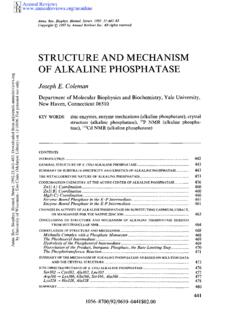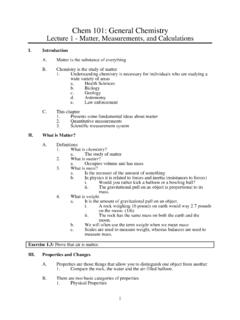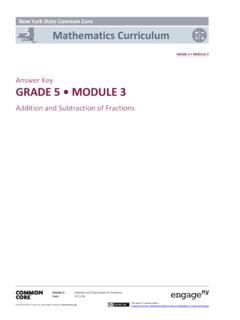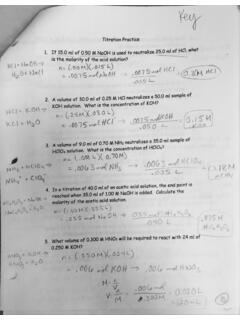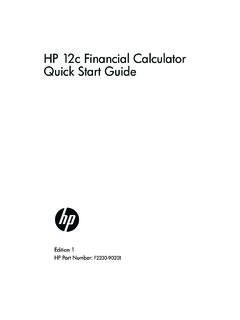Transcription of Chem 452 - Fall 2012 - Quiz 2 (Take Home, due Monday, …
1 Chem 452 - fall 2012 - quiz 2 (Take home , due monday , 22. Oct)You may discuss with others strategies for answering these questions, but what you hand in should represent your own work. You must show all calculations to receive full credit. Units are very the Michaelis-Menten equation, what is the vo/Vmax ratio when [S] = 3 KM? KM = 3 mM, and vo = 35 mol/(mL s) when [S] = 3 mM, what is the velocity, vo, for the reaction when [S] = 18 mM? following kinetic data were obtained for an enzyme in the absence of an inhibitor, and in the presence of two different inhibitors, (A) and (B), each at a concentration of mM.
2 Assume the total enzyme concentration, [E]T, is the same for each experiment.[S] {mM}without inhibitorvo { mol/(mL s)}with inhibitor Avo { mol/(mL s)}with inhibitor Bvo { mol/(mL s)} Name 1 Starting with the Michaelis-Menten equation:KM1+I[]KI Substitute [S]= 3 KM!voVmax=3 KM1 KM+3 KM=31+3voVmax=34 Starting with the Michaelis-Menten equation:vo=VmaxS[]KM+S[]We could substitute the values we have for KM, vo and [S] and solve for Vmax or we could simply recognize that since both [S] and KM equal 3 mM, vo = 35 mol/(mL s) must be the half-maximum velocity, which makes Vmax = 70 mol/(mL s).
3 Since [S] = 18 mM is equal to 6 KM, vo=VmaxS[]KM+S[]voVmax=6 KM1 KM+6 KM=61 + 6=67 (see Problem 1)vo=Vmax67 =70 mol/mL s()()67 =60 mol/mL s()Key2/22/210 Vmax and KM for the uninhibitedwithout inihibitorwithout inihibitorwith inibitor Awith inibitor Awith inhibitor Bwith inhibitor B[S]vo[S]vo[S] mol/(mL s) mol/(mL s) mol/(mL s) mol/(mL s) mol/(mL s) mol/(mL s) mol/(mL s) mol/(mL s) mol/(mL s) mol/(mL s) mol/(mL s) mol/(mL s) mol/(mL s) mol/(mL s) mol/(mL s) mol/(mL s) mol/(mL s) mol/(mL s)1/[S]1/vo1/[S]1/vo1/[S]1 1 (mL s)/ 1 (mL s)/ 1 (mL s)/ 1 (mL s)/ 1 (mL s)/ 1 (mL s)/ 1 (mL s)/ 1 (mL s)/ 1 (mL s)/ 1 (mL s)/ 1 (mL s)/ 1 (mL s)/ 1 (mL s)/ 1 (mL s)/ 1 (mL s)/ moleDetermined valuesDetermined valuesKM = mM(KM)app = mMKM = mMVmax = mol/(mL s)(Vmax)app = mol/(mL s)(Vmax)app = mol/(mL s)KI = KI = mMKI = mMChem 452 quiz 2 fall , 20122(Inhibitor decreases both KM and Vmax, by 1+I[]KI )Unncompetitivve inhibitionNoncompetitivve inhibition(Inhibitor increases KM by 1+I[]KI and leaves Vmax, unchanged)
4 The type of inhibition and the dissociation constant, KI, for inhibitor binding to the enzyme, for the two experiments that contain an A is an uncompetitive inhibitor. We know this because both KM and Vmax are decreased by the same amount, which is 1+I[]KI :Can solve for KI using either Vmax()app=Vmax1+I[]KI or KM()app=KM1+I[]KI VmaxVmax()app=1+I[]KI KI=I[]VmaxVmax()app 1 =10 mol/mL s() mol/mL s() 1 = B is a non competitive inhibitor. We know this because only Vmax is decreased by a factor of 1+I[]KI :Can solve for KI using Vmax()app=Vmax1+I[]KI VmaxVmax()app=1+I[]KI KI=I[]VmaxVmax()app 1 =10 mol/mL s() mol/mL s() 1 = catalyzes the first reaction in glycolysis and phosphorylates D-glucose to D-glucose 6-phosphate using ATP as the source of the phosphate:Under conditions of pH 7, 25 C and a Hexokinase concentration of nmol/mL, the KM for Hexokinase for the substrate glucose was determined to be x 10-4 M.
5 When the glucose concentration was set to 160 , the initial rate of the reaction was found to be mol/(mL s). is Vmax for Hexokinase under these conditions?vo=VmaxS[]KM+S[]=VmaxS[]KM+S[ ]Vmax=voKM+S[]()S[]= molmL s 4 M+160 M()160 M =186 molmL sChem 452 quiz 2 fall , 201236 is the turnover number for Hexokinase under these conditions? turnover number = kcat=VmaxE[]total=186 molmL 6molmL 9molmL=62,000 is the catalytic efficiency for Hexokinase under these conditions? catalytic efficiency =kcatKM=62,000 4 M= x 108/M s() Hexokinase display catalytic perfection under these conditions?
6 The catalytic efficiency is greater than 108/(M s), which puts it in the range that qualifies it to be considered catalytic perfection . determines the ultimate speed limit of an enzyme-catalyzed reaction? That is, what is it that imposes a physical limit on catalytic perfection? When an enzyme is catalytically perfect, the reaction rate has become dependent on the rate at which the substrate is able to diffuse into the active site. This rate places an upper limit of 108/(M s) to 109/(M s) on the catalytic efficiency of an enzyme catalyzed reaction. Beyond this, there is nothing that evolution can do to further increase the rate at which the enzyme catalyzes the a sentence, describe Hexokinase based on its Enzyme Commission (EC) number.
7 For example, the EC number for the enzyme Chymotrypsin is , which tells us that Chymotrypsin ( ) is a hydrolase ( ) and serine type endopeptidase ( ) that cleaves peptide bonds ( ).The number for Hexokinase is , which tells us that Hexokinase ( ) is a transferase ( ) that transfers a phosphate group ( ) to an alcohol group as the acceptor ( ) to produce a phosphate myoglobin and hemoglobin function as oxygen binding proteins, contains an Fe2+ ion, which desires to interacts with six ligands. Describe the six ligand interactions that an Fe2+ ion in six ligand from an octahedral around the Fe2+.
8 Four of the ligands are the nitrogens provided by the porphyrin ring and all lie in the same ring. The fifth ligand is a nitrogen from a histidine side chain (the proximal histidine) and the six ligand is used bind the oxygen distal histidine, while not one of the ligands for the Fe2+ ion, nonetheless plays some important roles with respect to oxygen binding by hemoglobin. Describe two of distal histidine s side chain imidazole sits near the site where the O2 binds. (1) It hydrogen bonds to the bound O2 and helps prevent it being release as a destructive super oxide radical (O2-), which would also leave the iron as Fe3+, and kill the myoglobin as well.
9 (2) The distal histidine also forces the sixth ligand that binds to the heme group to bind at an angle. This is not an issue for the intended oxygen ligand, which prefers to bind at an angle, but it, in particular, lowers the affinity for the toxic carbon monoxide (CO), which prefers to bind straight on, at right angles to the heme the axes provided below, illustrate how the binding of oxygen to myoglobin differs from that for hemoglobin. Draw your curves showing myoglobin with a P50 of 5 torr and showing hemoglobin with a P50 of 25 torr (Be sure to label your curves.)Chem 452 quiz 2 fall , 201245 how the behaviors illustrated above optimize myoglobin and hemoglobin for their different physiological oxygen-binding role for Hb is to circulate in the blood and pick up O2 in the lungs and deliver it to the tissues, such as muscles, where it passes the O2 over to a Mb molecule, which then holds on to it until needed.
10 The binding curve for Hb shows that it can become nearly fully saturated with O2 when in the lung, where the pO2 for oxygen is around 100 torr. As the O2-bound Hb moves out the the tissues, the pO2 levels fall . In the process, the Hb s affinity for O2 falls off more rapidly than that for Mb. This helps to optimize Hb s ability to then transfer its O2 cargo to an awaiting Mb the pO2 in the lungs is 100 torr, and the pO2 in active muscles is 25 torr, assuming a Hill coefficient of n = for hemoglobin, what percentage of the O2 picked up by the hemoglobin in the lungs will be released to the myoglobin in the muscles?
